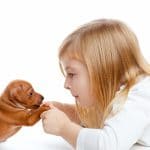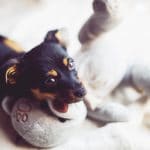Getting Started
Before you begin training your puppy, there are a basic few items you’ll need to acquire first.
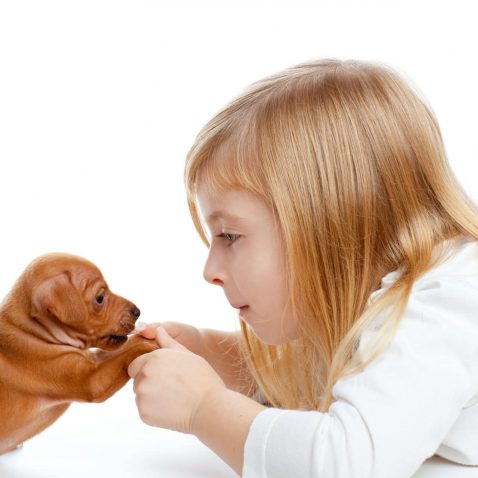
How to Potty Train a Puppy: Getting Started
Key Potty Training Tools Needed:
- A Leash: You’ll need to take your puppy out on a training leash, so they aren’t tempted to play instead of potty – even if you have a fenced-in yard. It will also allow you to keep them close by so you can reward them with a treat when they have done their business.
- Treats & Toys: When you give your pup a small treat or toy immediately after they potty, it will positively reinforce the appropriate behavior.
- A Baby Gate: For when you need to leave a section of your home unsupervised. These are a great way to keep your puppy from sneaking away to explore other parts of the house.
- Stain and Odor Remover: Great for preventing your puppy from seeking out spots they’ve already soiled when the right kind of cleaner is utilized.
- Puppy Pee Pads: These are amazing for keeping your puppy from soiling anywhere they please – and only in a concentrated area. Just until they are trained properly to go outside, especially if you go for the crate training route.
- A Puppy Crate (Optional): A properly-sized crate will do a few things for you – it will keep your puppy safe when you can’t watch them. As well as helps your pup learn to hold it because they want to keep their den clean.
After you’ve obtained these items and gotten your puppy home, you’ll have to begin showing them where you want them to go potty.
Typically, this will be your garden or backyard. Or if you don’t have one, an outside area very near to your home.
Once, these tools and steps have been followed, it’s time for the real training to begin.
Housetraining Your Puppy Begins: Steps to Follow
It is recommended by experts to confine your puppy to a defined space. Whether that space is a crate, in a room, or on a leash.
As your new pup learns that they need to go outside to do their business – you can gradually give them more freedom to roam.
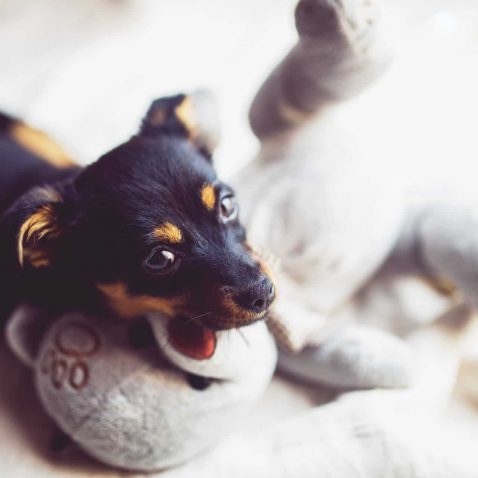
The below steps are essential to potty training your new pup:
- Incorporate Regular Feeding Schedules: Feed your pup at the same scheduled times every day.
- Keep a Schedule for Doing the Deed: You’ll want to take your pup out to relieve themselves first thing in the morning, and then once every 30 minutes to an hour. You’ll also want to take them out, after meals or when they wake from a nap. Its essential to you also take them out just before bed, so no accidents happen during the night.
- Choose a Designated Spot for Potty Time: When you take your puppy to the same spot each time to do business, their scent will prompt them to go.
- Stay with Your Pup Outside: When you do this, at least until they’re house trained, it acts as a cue that its potty time.
- Positive Reinforcement: When your puppy relieves themselves outside, reward them with praise, a treat, or even a walk around the neighborhood.
Schedules are vital to housetraining success and will require you to monitor your puppy’s habits before setting one.
Keep in mind that puppies have tiny bladders and water will run right through them, as with their gut and solid matter.
A 6-month old pup can only be expected to hold it for approximately 6 hours.
The Indoors to Outdoors Method
One thing essential to this method of potty training is you should learn to recognize the signs of when your puppy needs to go.
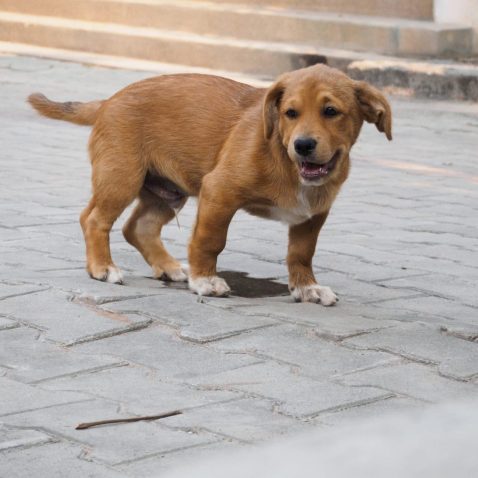
Puppies may present slightly varying behavior when needing to potty but here are some pretty universal traits a puppy may show when needing to go:
- Sniffing the floor
- Circling
- Looking restless
- Going into a room, they have previously messed in
- Barking or scratching at the door
- Smelling their rear
- Squatting
The indoors-to-outdoors method.
For this method, you start the training indoors limiting the space your puppy needs to begin with if possible.
To start, you place puppy pads in with your puppy covering the entire area of the room or house.
When a pup does his business make sure to change the pee pads frequently – adding a piece of the soiled pad on top of the new. This way, your pups scent will help them recognize the area where they regularly go to potty.
Over time gradually eliminate the total area of pee pads until they are down to just 1 or 2. If all is going well your pup should now be using the small area of pee pads left, this is great and means the training is working.
The next stage you place a used pee pad outside and remove all pee pads from your room or house, at this point, you will have to take your pup outside regularly for potty time, every 30 minutes or so. Your puppy will then associate his scent and going potty with being outside.
You will finish with the eventual removal of all pads. We have found this method of potty training to be the most simple and effective, I had my Labrador house trained within 3 days using this method. But of course not every dog will house train at the same rate, and different breeds are more stubborn when it comes to training so remember to have patience and understand that these things can take time.
It is also important to note the substantial effect positive reinforcement will have when training your pup when he/she does go potty outside. Praising them and rewarding them with small treats is all this requires.
Another point to add is don’t react angrily or harshly when your dog does make mistakes because in this case, your pup will not understand the behavior he is being punished for. Positive reinforcement of good behavior is KEY.
Problems that May Arise During Housetraining
Accidents happen. It’s a simple rule of life, no matter how much you try to prevent them.
It’s merely a matter of correcting their behaviour and using positive reinforcement when they display the preferred behavior.
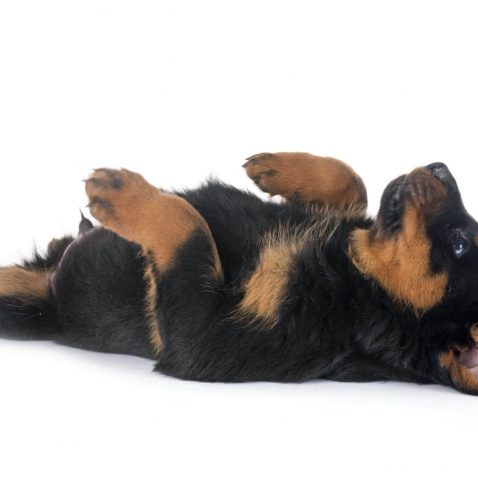
When accidents do happen, calmly address the situation. Punishing your pup for them can make the situation worse, and result in more mishaps in the home.
Instead, quickly redirect them to the designated potty spot right away or outside dependant on which stage of the training you are at. Then clean up the mess as soon as possible.
If accidents continue to happen despite your best efforts then it may be necessary to take your puppy the vets to make sure there are no hidden medical issues. If they do not, then just stick to the plan persistence and consistency with dogs are also KEY factors.
Additional Tips, Tricks, & Helpful Know-How For Potty Training
One thing to keep in mind is this could be for the long haul.
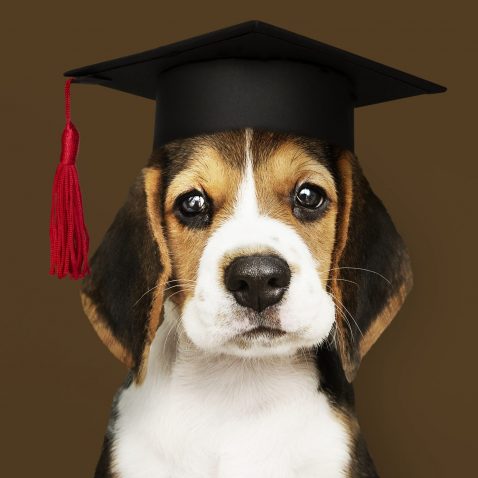
The potty training average for most puppies is around that 4-6 month mark, whilst some may be remarkable quicker than this especially if they’re an intelligent breed, not all dogs can be trained at such a rate, some may take up to a year.
Determining bathroom-time frequency will be majorly beneficial during the training period.
One indicator that can be used to predict how frequently your new puppy will need to go is his/hers size.
For example, if you have a smaller breed, they have smaller bladders and higher metabolisms. Which will require more frequent trips outside.
The recommended age you begin house training your puppy by experts is when your pup is between 12 weeks and 16 weeks old. Because at that point, they have developed enough to learn how to hold it and control themselves.
Summary
Just like with any other form of training you want to do for your pup, consistency is key. Mixed with a little bit of patience.
Well, a LOT of patience in this instance.
A new puppy is a commitment, the training even more so, remember to be patient, be consistent and most of all be positive.
We hope you enjoyed this article, and that it assisted you with potty training your new pup! Let us know how these tips went well for you – or if you have any questions please ask or leave a comment below.
Share the Love
If you found this post useful, please let others know about it by sharing it.

